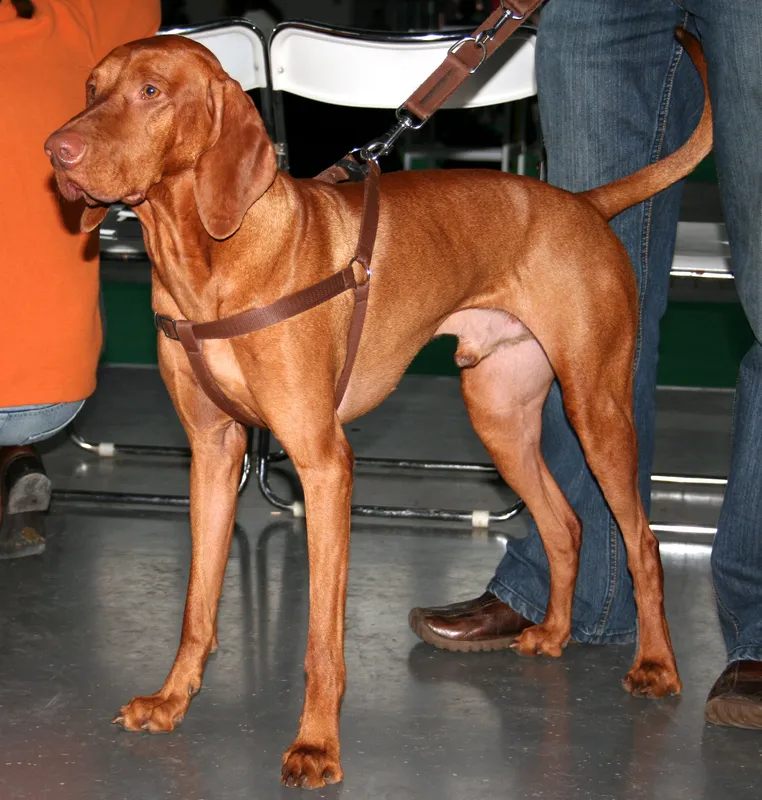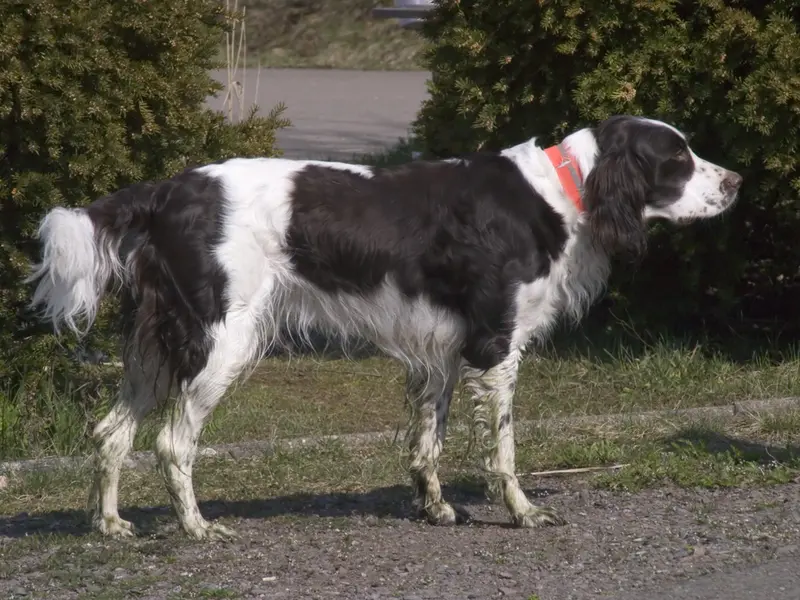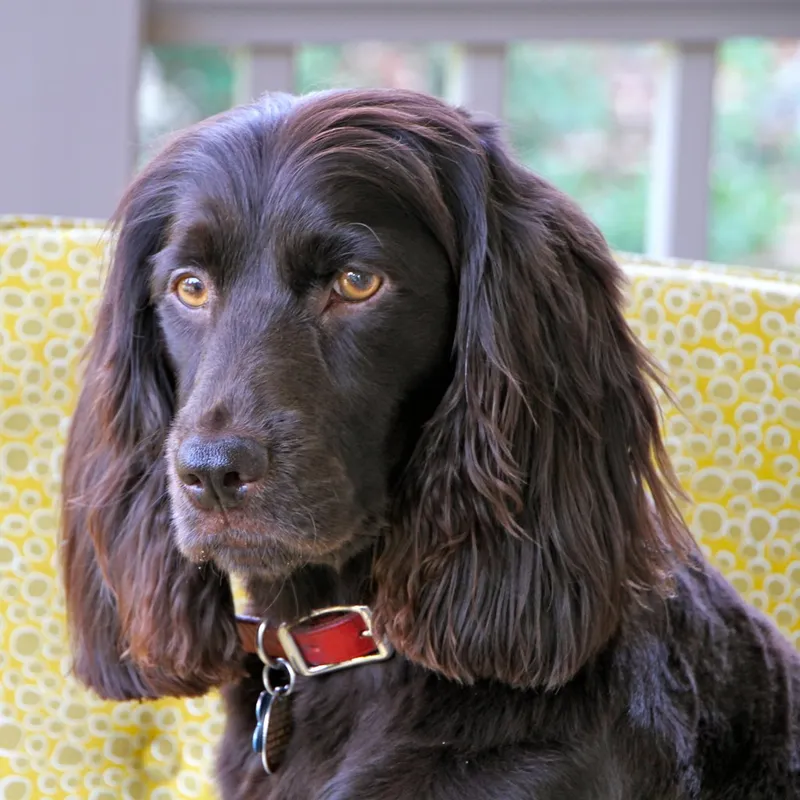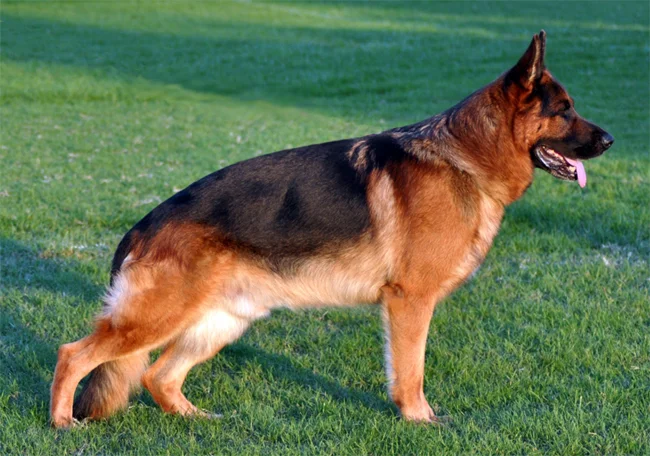Wirehaired Vizsla
The Wirehaired Vizsla is a medium-sized, affectionate hunting dog from Hungary, known for its versatility, intelligence, and strong bond with families.
Overview
🐕Breed Overview
✨Key Traits
💡What Makes Wirehaired Vizsla Special
The Wirehaired Vizsla stands out for its versatility as both a hunting dog and a family companion. Its strong work ethic and natural hunting instincts make it an excellent choice for active families who enjoy outdoor activities.
The breed's affectionate nature and loyalty ensure that they are not just working dogs but also loving family members. Their adaptability allows them to thrive in various environments, provided their exercise and social needs are met.
Additionally, their unique wiry coat offers protection against the elements, making them suitable for hunting in diverse conditions. These traits combined make the Wirehaired Vizsla a remarkable breed for those seeking an energetic and devoted companion.
The Wirehaired Vizsla is a medium-sized hunting dog that embodies versatility, intelligence, and affection. Originating from Hungary, this breed was developed in the 1930s to combine the excellent qualities of the Vizsla with a sturdier frame and a weather-resistant coat. With a height ranging from 21 to 25 inches and a weight of 40 to 55 pounds, Wirehaired Vizslas are robust yet agile, making them ideal companions for active families and hunters alike.
Their striking russet to golden sand coat is wiry and dense, providing protection against harsh weather conditions. Wirehaired Vizslas are known for their exceptional hunting abilities, excelling in pointing and retrieving game both on land and in water. Their keen sense of smell and above-average trainability make them a favorite among hunters.
However, they are not just working dogs; they are also affectionate companions that thrive on human interaction. Their gentle demeanor and loyalty make them great family pets, particularly around children. Despite their high energy levels, Wirehaired Vizslas are adaptable and can thrive in various living situations, provided they receive adequate exercise and mental stimulation.
They require at least 30 minutes to an hour of vigorous activity daily, which can include hiking, swimming, or playing fetch. Their grooming needs are moderate, requiring regular brushing to maintain their wiry coat. In terms of temperament, Wirehaired Vizslas are playful, friendly, and eager to please.
They bond closely with their families and can be reserved around strangers. Their intelligence allows for effective training, though they respond best to positive reinforcement methods. Overall, the Wirehaired Vizsla is a remarkable breed that combines the best traits of a hunting dog with the affectionate nature of a family companion, making them a perfect fit for active households.
🎉Fun Facts
The breed's wiry coat helps protect them from harsh weather conditions, making them excellent hunting companions year-round.
They are sometimes referred to as 'Velcro dogs' due to their strong desire to be close to their owners.
Wirehaired Vizslas are known for their exceptional swimming abilities and often enjoy water activities.
Breed Characteristics
Family & Friends
Good Behavior
Get Up & Go
Household Harmony
Temperament & Personality
✨Key Traits
🐕Core Temperament
The Wirehaired Vizsla is characterized by its friendly and affectionate temperament. They are lively and playful, making them great companions for families and active individuals.
' While they can be reserved with strangers, they are generally friendly and sociable. Their intelligence and eagerness to please make them trainable, although they require positive reinforcement methods to thrive.
Overall, their temperament is well-suited for family life, as they are gentle, loving, and protective.
💫Personality Profile
Wirehaired Vizslas are known for their lively and affectionate nature. They form strong bonds with their families and thrive on companionship, often seeking to be involved in family activities.
Their playful demeanor makes them great with children, and they are generally friendly towards other pets. While they can be reserved around strangers, they are not aggressive and will often greet new people with curiosity.
Their intelligence and eagerness to please make them relatively easy to train, although they can exhibit stubbornness if not motivated properly. Overall, they are gentle, loyal, and sensitive dogs that require regular interaction and mental stimulation to stay happy and healthy.
🔊Vocal Tendencies
Wirehaired Vizslas are generally quiet dogs, barking only when necessary or if they feel provoked. They may bark to alert their owners of strangers or unusual sounds, but they are not known to be excessive barkers.
Their vocalizations are typically friendly and not aggressive, making them suitable for family environments. However, they may whine or cry if they feel neglected or anxious, as they thrive on companionship and attention from their owners.
Overall, their noise level is moderate, and they can adapt well to various living situations without being overly disruptive.
Affection & Social Traits
Energy & Activity
Communication Style
Care Requirements
🏃♂️Exercise Requirements
Daily Exercise
The Wirehaired Vizsla is an energetic breed that requires a significant amount of exercise to maintain its physical and mental well-being. Ideally, they need at least 30 minutes to an hour of vigorous exercise daily. This can include activities such as running, swimming, hiking, or playing fetch.
Given their hunting background, they thrive in environments where they can explore and engage in activities that stimulate their natural instincts. Puppies may require shorter, more frequent play sessions to avoid overexertion, while senior dogs may benefit from gentler activities like leisurely walks or swimming. Regular exercise helps prevent behavioral issues such as hyperactivity or destructive tendencies, which can arise from boredom or lack of stimulation.
Overall, consistent physical activity is crucial for the Wirehaired Vizsla's happiness and health.
Preferred Activities
🏠Living & Adaptability
Space Requirements
Wirehaired Vizslas are medium-sized dogs that adapt well to various living environments, but they thrive best in homes with ample outdoor space. A large yard is ideal, as it allows them to run and play freely.
However, they can also adapt to apartment living if their exercise needs are met through regular outdoor activities. Owners in smaller spaces should ensure they provide sufficient daily exercise and mental stimulation, such as interactive play or trips to dog parks.
Without adequate space and stimulation, these dogs may exhibit destructive behaviors or anxiety. Overall, a secure and spacious environment is essential for their well-being.
Climate Preference
🍲Feeding Guide
Schedule
Food Types
Portion Size
Special Nutritional Needs
Wirehaired Vizslas do not have specific dietary restrictions, but it's essential to provide a balanced diet rich in protein to support their active lifestyle. Some may have food sensitivities, so monitoring their reactions to new foods is advisable. Regular vet check-ups can help identify any dietary needs or allergies.
✨Grooming Requirements
Grooming Overview
The Wirehaired Vizsla's coat requires moderate grooming to keep it healthy and looking its best. 25 inches in length. Regular brushing is necessary to remove dead hair and prevent matting, ideally done once a week.
Hand stripping may be required occasionally to maintain the coat's texture and appearance. Bathing should be done as needed, especially after outdoor activities, to keep their coat clean. Pay special attention to the beard and eyebrows, as they can trap moisture and debris.
Regular nail trimming and ear cleaning are also essential parts of their grooming routine.
Care Schedule
Brush weekly, bathe as needed, trim nails every two weeks.
Health Profile
⚕️Health Care
Regular health care is crucial for the Wirehaired Vizsla's lifespan. Routine veterinary check-ups, vaccinations, and preventive treatments can help detect and address health issues early.
Maintaining a consistent schedule for vaccinations and parasite control is essential for their overall health. Additionally, dental care is important, as dental disease can lead to other health complications.
Owners should also monitor their dog's weight and adjust their diet and exercise accordingly to prevent obesity, which can lead to various health problems. Overall, proactive health care practices can significantly enhance the Wirehaired Vizsla's quality of life and longevity.
Health Issues Overview
⏳Average Lifespan
Genetic Factors
Genetics play a significant role in the Wirehaired Vizsla's lifespan, as certain hereditary health issues can impact their overall health and longevity. Responsible breeding practices that prioritize genetic diversity and health testing can help reduce the risk of inherited conditions.
Potential owners should seek reputable breeders who conduct health screenings for common issues such as hip dysplasia and epilepsy. Understanding the genetic background of a Wirehaired Vizsla can help owners make informed decisions about their care and management, ultimately contributing to a longer, healthier life.
Living Conditions
The Wirehaired Vizsla's lifespan can be influenced by various environmental factors, including the quality of care, exercise, and social interactions. Dogs that live in active households with ample opportunities for exercise and mental stimulation tend to live longer, healthier lives.
Regular veterinary care, a balanced diet, and a safe living environment also contribute to their overall well-being. Exposure to harsh weather conditions without proper shelter can negatively impact their health, so providing a comfortable living space is essential.
Additionally, social interactions with humans and other pets can enhance their emotional health, reducing stress and anxiety, which can also affect longevity.
🏥Common Health Issues
Hip Dysplasia
Warning Signs
🔬Diagnosis
X-rays and physical examination by a veterinarian.
💊Treatment
Medications, weight management, and in severe cases, surgery.
📝Management Tips
Maintain a healthy weight, provide joint supplements, and avoid excessive jumping or strenuous activities.
Epilepsy
Warning Signs
🔬Diagnosis
Neurological examination and possibly an MRI.
💊Treatment
Anticonvulsant medications.
📝Management Tips
Regular veterinary check-ups and medication as prescribed.
Food Allergies
Warning Signs
🔬Diagnosis
Elimination diet and allergy testing.
💊Treatment
Dietary changes and medications as needed.
📝Management Tips
Identify and avoid allergens, provide a hypoallergenic diet.
🛡️Preventive Care
🔬Hip Evaluation
Hip Evaluation assesses the hip joints for dysplasia and other abnormalities, crucial for preventing mobility issues.
📅 Annually after 2 years of age.
🔬Eye Examination
Eye Examination checks for hereditary eye conditions that can affect vision and overall health.
📅 Every 1-2 years, or as recommended by a veterinarian.
🔬Thyroid Testing
Thyroid Testing evaluates thyroid function to identify potential hormonal imbalances that can affect energy levels and weight.
📅 Annually after 2 years of age.
Training
🧠Intelligence & Trainability
💪Work Drive
Wirehaired Vizslas possess a strong work drive, stemming from their history as hunting dogs. They thrive when given tasks or jobs to do, whether it's participating in field trials, engaging in scent work, or simply accompanying their owners on outdoor adventures.
Mental stimulation is just as important as physical exercise for this breed, as they enjoy challenges that engage their intelligence. Activities such as puzzle toys, obedience training, and interactive games can help satisfy their need for mental engagement.
Without sufficient stimulation, they may become bored and exhibit destructive behaviors, so providing regular opportunities for work and play is essential.
⚠️Training Considerations
Wirehaired Vizslas may exhibit stubbornness during training, particularly if harsh methods are employed. Their sensitive nature requires a gentle approach, as they can become anxious or resistant to training if they perceive it as punitive.
Common challenges include distractions during training sessions and a tendency to become overly excited, which can lead to impulsive behavior. To overcome these challenges, owners should employ positive reinforcement techniques, such as treats and praise, to encourage desired behaviors.
Consistent training routines and early socialization are essential to help them develop good manners and adaptability in various situations. Engaging them in mentally stimulating activities can also help mitigate behavioral issues.
📝Training Tips
Training a Wirehaired Vizsla requires patience and consistency. Start with basic obedience commands, using positive reinforcement methods to encourage learning. Short, engaging training sessions are ideal, as these dogs can become bored with lengthy practices.
Incorporate fun activities like agility training or scent work to keep them mentally stimulated. Socialization is crucial, so expose them to different environments, people, and other animals from a young age. This breed responds well to gentle correction and thrives on praise and rewards.
Establishing a strong bond with your Wirehaired Vizsla through play and interaction will enhance their willingness to learn and cooperate during training.
History & Heritage
📜Origin Story
The Wirehaired Vizsla's origin can be traced back to the 1930s in Hungary, where hunters and falconers sought a dog that could withstand the rigors of hunting in cold weather and dense undergrowth. The breed was developed by crossing two Vizsla females with a solid-colored German Wirehaired Pointer, resulting in a dog that combined the Vizsla's excellent hunting instincts with a more robust frame and a wiry coat.
This new breed was designed to excel in various hunting environments, including water and rough terrain. Despite facing challenges during World War II, dedicated breeders worked to preserve the Wirehaired Vizsla, leading to its recognition by the Federation Cynologique Internationale (FCI) in 1966.
The breed's introduction to North America in the 1970s further solidified its status as a versatile hunting dog and cherished family companion.
⏳Development History
The Wirehaired Vizsla was developed in the 1930s by Hungarian breeders who sought to create a sturdier version of the Vizsla with a weather-resistant coat. The breed's foundation involved crossing two female Vizslas with a solid-colored German Wirehaired Pointer.
This breeding aimed to enhance the Vizsla's hunting capabilities in harsh weather conditions. The breed faced challenges during World War II, which led to a decline in numbers, but dedicated breeders worked to preserve and promote the Wirehaired Vizsla.
Official recognition came in Europe in 1966, and the breed was introduced to North America in the 1970s, where it has since gained popularity among hunting enthusiasts and families alike.
🛡️Purpose & Historical Role
Historically, the Wirehaired Vizsla was bred for hunting and retrieving game in various terrains, including water and dense underbrush. Its development aimed to create a dog that could perform well in harsh weather conditions, making it an ideal companion for hunters.
The breed's natural instincts for pointing and retrieving have made it a valuable asset in hunting expeditions. Today, the Wirehaired Vizsla continues to excel in hunting, field trials, and various canine sports, showcasing its versatility and adaptability.
Additionally, its affectionate nature has made it a beloved family pet, fulfilling roles as both a working dog and a loyal companion.
🏺Cultural Significance
The Wirehaired Vizsla is a breed deeply rooted in Hungarian culture, originally developed to serve as a versatile hunting companion. Its unique combination of traits, including a robust build and weather-resistant coat, reflects the needs of hunters in Hungary's diverse terrains.
The breed's historical significance is highlighted by its role in falconry and hunting, where it was prized for its ability to point and retrieve game. Over time, the Wirehaired Vizsla has gained recognition not only as a skilled hunting dog but also as a beloved family companion, showcasing its adaptability and affectionate nature.
This breed's presence in popular culture is growing, as more families appreciate its loyalty and versatility.
Conservation Status
This breed is rare and not commonly found outside its region of origin.









